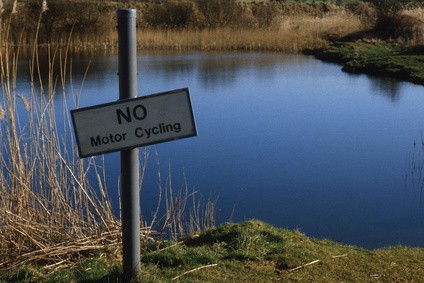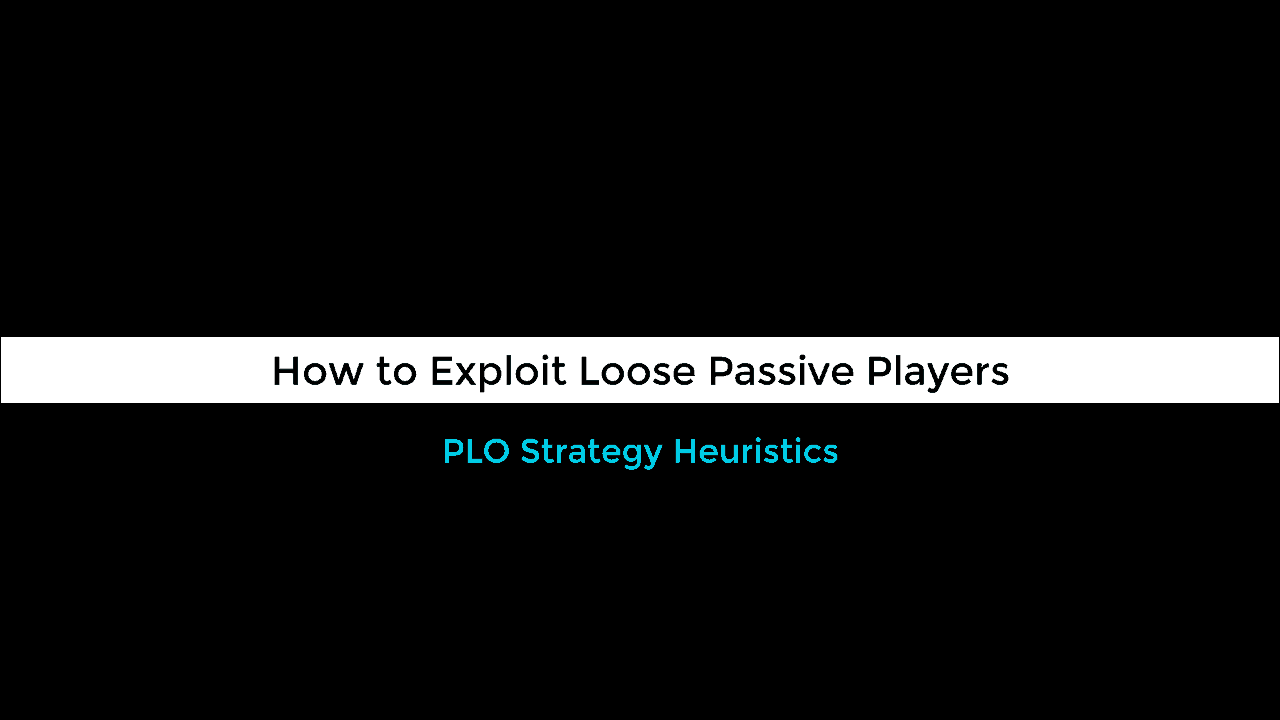George Orwell
With some signs, the writing doesn’t matter- those who need it won’t read it, and those who will read it didn’t need it.
This thought struck me after I had written this article, since it’s most useful for those players who insist on attempting to play ‘maximally exploitative poker’, and those same players are least likely to read it. Since you’ve stopped by though (and thanks and welcome back!) you’ll get some mathematical reinforcement as to why you (unlike those other guys) balance your ranges.
There are two broad classes of error in poker. The most easily recognizable are those of ignorance, which can be as simple as making a pot-odds mistake calling off your stack with a draw, or as complex as not knowing where you are in your range when bluff-catching. The hidden, far more interesting sources of error are errors of predictability. We’ll discuss here an easy and effective way to make you a tougher opponent at the tables, which is to avoid ‘always-or-never’ betting lines
Almost does count
| Observed Raises(10 opportunities) | Probability | Observed Raises(100 opportunities) | Probability |
| <7 | 12% | <75 | 9% |
| 7 | 20% | 75 | 4% |
| 8 | 30% | 80 | 10% |
| 9 | 27% | 85 | 5% |
| 10 | 11% | >85 | 8% |
As the table above demonstrates, over a small sample of 10 opportunities our opponent is going to observe us opening 9 or 10 times more often than he will observe us opening our ‘true raise frequency’ of 8 times. Even when the sample has increased to 100 times, he will only observe us opening within the 75-85% interval 83% of the time. Whilst by this point in a match he should have a good idea of our open-raising range, it has taken him a significant number of hands to have confidence in his estimate2. Were we open-raising 100% of the time, he could long since have made a (correct) assumption about our opening range and focused his attention on other matters.
The 80-20 raise-limp split also offers another information-hiding benefit, which is that we can change the hands which comprise each separate distribution without changing the observed frequency of raises. No such flexibility is permitted with a 100% open-raising frequency. Were our opponent to auto-raise the 20% limped fraction, perceiving it to be weak, we could adjust by limping our strongest 20% of hands, enabling us to guarantee playing them in position in a raised (or even 3-bet) pot versus a wide range.
Never play ‘never’
We call a UTG raise on the button 200BB deep and go heads-up to a flop of:
Q♠J♥J♠
We call a half-pot bet on the flop to see a turn 7♠; our opponent follows through with a pot-size bet on the turn and the river brings the 3♣. The board reads:
Q♠J♥J♠7♠3♣
and we face another pot-size bet of 51BB, with a total effective stack of 175.25BB, leaving us around 124BB if we wish to shove over this bet. My question to you is, what hands are you bluff-raising here?
It’s not the case that you have to have a raising range here; you might choose to raise the top of your range earlier in the hand, and mix bluffs in there, leaving you with a range of bluff-catchers on the river. However, if you do have a raising range here at all, then against a competent opponent you must include some bluffs. The fact that many players never bluff-raise the river, even at the highest stake levels, explains some of the more curious (at least to me) hand queries posted on poker fora. The reason never bluffing here is a terrible mistake is that one holds ‘the nuts’ relatively frequently in PLO, and thus stacking our opponent’s with nut hands accounts for much of the money in the plus side of the balance sheet. If your opponent can fold QJ here without a second thought, then once he starts doing so your win-rate suffers greatly. A quick glance over my own database shows a poor success rate for my bluffs in this situation, and so a simple (and erroneous) assumption would be that I could profit more by not bluffing. However, what my database does not show is the money that I win here when my opponents pay off my strong hands because they know that I am capable of bluffing.
Do you take care to mix in bluffs in every situation that your range is strong, or are you always strictly exploitative? Please let me know, and if you have any hand examples where you attempted a bluff in a similar spot, please share in the comments!







how could an apponent think about his hand with QJ?
Hi Phil, good article. I agree with the recommendation of sometimes limping in HUPLO. Even at relatively small stakes, say 400 and below, quite a few regs base their BB defense strategy on a high 3-bet frequency, and do not know how to adapt versus a opening strategy split between limping and raising.
I will note in passing that I dont quite agree with “When an action is taken 100% of the time, no matter if our opponent observes 1, 10 or 100 samples, his ‘best guess’ of our range will in fact be a perfect representation.” Even when you see an opponent perform an action a 100% of the time on a small sample, your best guess of the frequency should not be 100% if this 100% frequency is rare within the overall population of players.
Thanks for your comment JJ.
My choice of pronoun there was deliberate- “His best guess” rather than “Your best guess”.
For OUR best guess your point is highly relevant. You are suggesting we use Bayesian Inference (which I plan to discuss in a future article) as a guide to estimating a player’s actual frequency of a given action when we have little information. However that opens up an entire discussion in itself- even a player who we have no playing history with may have some tells (Screenname, country…) that make him more likely to be in a specific sub-population (Reg, Fish…). I’m sure you’ll understand why I didn’t go down that path in this article.
However I’m happy making the assumption here that our opponent isn’t going to use Bayesian Inference to guide his decisions. Thus stating that HIS best guess from a naive statistical perspective will be a perfect representation is a better prediction of his prediction(!)
I miss the subtle choice of pronoun 🙂
Hi, first of all i wanted to say that love your articles. You’re a lot like me and I think you can (if u arent already) reach the top of the world in this game.
About the QJJ board i have bluffed there sometimes(with success) and i feel quite confident to bluff there against weak players, and never have a bluff range there against better ones or perhaps against real agressive players i can see myself have a raise range there.
A friend of mine said that he liked to bluff in those situations(also with success) he plays about mid-high stake. Dont know about the sample.
The biggest reason obv for not bluffing is because you rep so thin. Even if u have QQ quite often, say you will choose to just call 2 streets like 10% of the time. That means you’re down to very few combos and that makes it even fewer bluffs gto wise.
Hi Jock, thanks for your kind words.
You’re absolutely right that we aren’t looking for an enormous bluffing frequency on the river on the QJJ texture. However, the focus of the article is that there’s a huge difference between sometimes and never. In fact there’s a much bigger difference from our opponent’s perspective playing against somebody who goes from 0 to 1% bluffs here than from 1% to n%. For example you could choose to only bluff when there’s a ‘9’ in the minutes of your computer clock to get a 10% bluffing frequency whenever you hold a bare Queen. That small change makes you much harder to play against than the standard nit who only raises the nuts here.
Would you say an about 20% limping range with our strongest/weakest hands in it could out perform the merrits of playing them in a pure raise/4bet way? Or was this 80/20 thought just for the matters of being an example? Anyways an inspiring idea! I guess it depends on our opponent as usual and shouldn’t be done as a fixed strategy 🙂
Thank you for your comment Ronald. The 80/20 argument was there primarily by way of example, however I do personally believe that having a limping range OTB is optimal. In the present games one can simply tailor the limping range depending on our opponent’s style. Start by limping a mix of hands that you don’t want to play in a 3-bet pot with against a high frequency 3-bettor, for example. He is then forced to either adjust by 3-betting less than he would were you to raise 100%, or face the consequences of playing OOP against your enhanced range. Then, when he stops 3-betting, you could mix some of the hands you were limping with back into your raising range. Thus you can still be playing an ‘exploitative’ style, but the way in which you are exploiting your opponent is hidden.